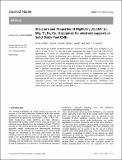Structure and properties of MgMxCr2-xO4 (M = Li, Mg, Ti, Fe, Cu, Ga) spinels for electrode supports in solid oxide fuel cells
Abstract
Novel electrode scaffold materials based on chromium-rich spinets, such as MgMxCr2-xO4, = Li, Mg, Ti, Fe, Cu, Ga) have been investigated for solid oxide fuel cell (SOFC) applications, in terms of conductivity and chemical stability when operated in fuel environments. Cation distributions were obtained by Rietveld refinement from X-ray diffraction data (XRD), with cation site preference considered in agreement with literature, and correlated with electrical properties determined experimentally. The substitutions with cations such as Li and Cu on B site improved the conductivity of the materials in air, while introducing Fe and Ga in the structure led to a decrease in conductivity in air. However, Fe had a positive contribution under reducing conditions, generating a change in the conductivity mechanism from p-type in air, to n-type. Conductivity measurements indicated that MgFexCr2-xO4 spinets exhibit faster reduction kinetics, in comparison with other substituted cations at the B site which is desirable in fuel cell application, for a reasonably fast response of a cell or a stack to reach its full functional potential. MgFeCrO4 showed fast reduction kinetics, with increase of the conductivity in reducing conditions from 0.014 S cm-1 to 0.4 S cm-1 and equilibration time for reaching the maximum conductivity value of 10 hours, under dry 5% H2/Ar at 850 degrees °C.
Citation
Stefan , E , Connor , P A , Azad , A K & Irvine , J T S 2014 , ' Structure and properties of MgM x Cr 2-x O 4 (M = Li, Mg, Ti, Fe, Cu, Ga) spinels for electrode supports in solid oxide fuel cells ' , Journal of Materials Chemistry A , vol. 2 , no. 42 , pp. 18106-18114 . https://doi.org/10.1039/c4ta03633f
Publication
Journal of Materials Chemistry A
Status
Peer reviewed
ISSN
2050-7488Type
Journal article
Description
The authors thank the Office of Naval Research, USA, grant code N00014-11-1-0247, the Engineering and Physical Sciences Research Council, UK, grant platform EP/E064248/1 and the European Union's Seventh Framework Programme (FP7/2007-2013) for the Fuel Cell and Hydrogen Joint Technology initiative under grant agreement no. [FCH JU-GA 278257]10 for financial support.Collections
Items in the St Andrews Research Repository are protected by copyright, with all rights reserved, unless otherwise indicated.

